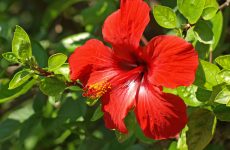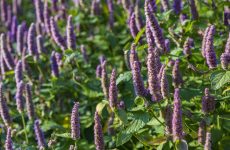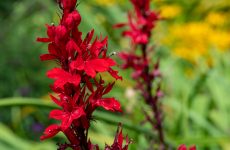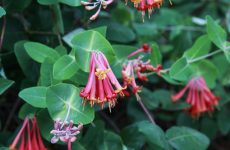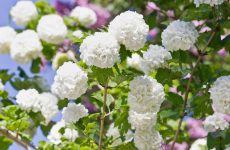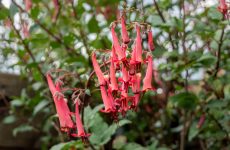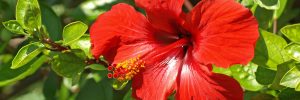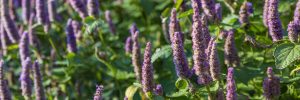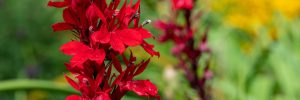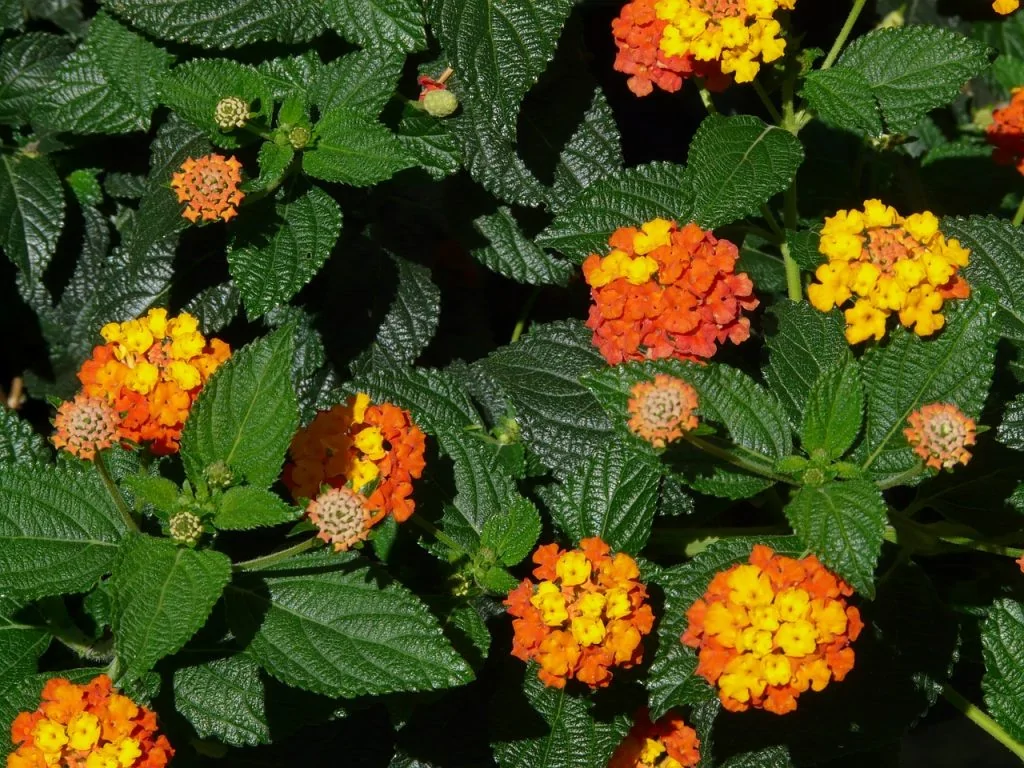
Hummingbirds don’t just go for red flowers as it’s the nectar the plants produce they are really interested in. So they are attracted to many different colored flowers.
Great news for you as you can create a gorgeous statement garden filled with orange flowers that hummingbirds love. You need to check the plant hardiness for your area and make sure the orange plants that you choose survive and thrive in your zone.
These plants may be available in many different colors, but they are available in orange varieties that you can fill your yard with to bring the hummingbirds flocking.
20 Orange Flowers That Hummingbirds Like:
1. Ligularia
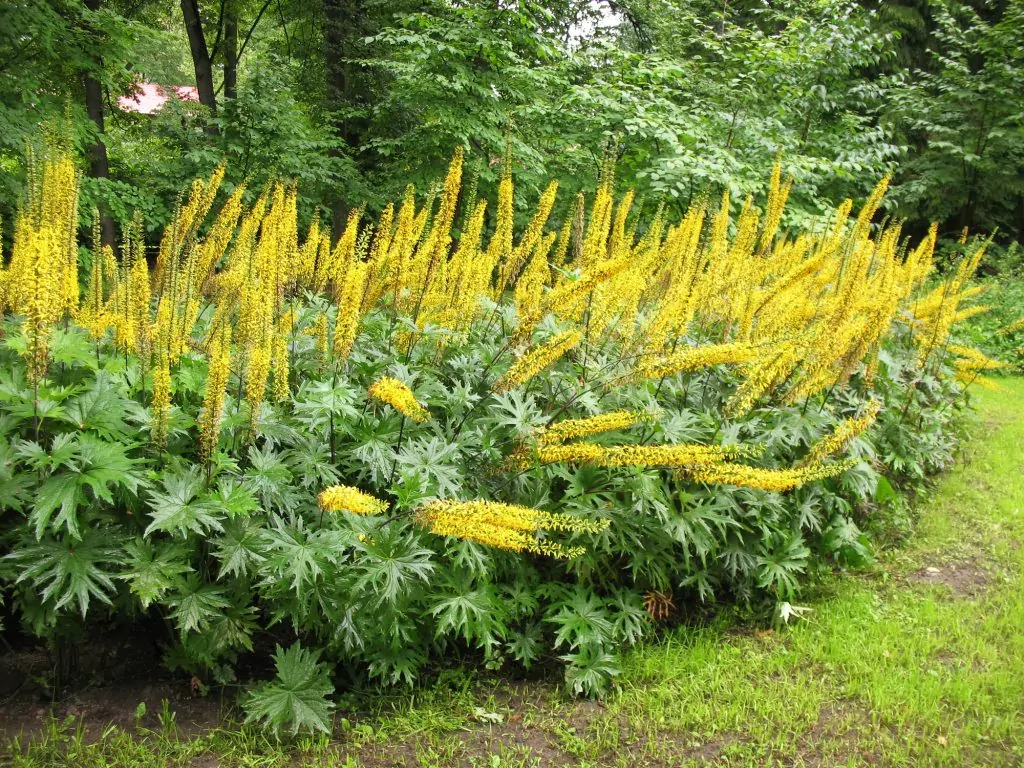
Ligularia is a fantastic addition to a shade garden. The tall spikes of flowers in bright yellow really pop against the green leaves.
The leaves of the ligularia add more interest and come in deep green and are large and heart-shaped or thin and deeply serrated.
They prefer moist soil, out of the heat of the day, and they will wilt if too hot and dry.
Hummingbirds will love to visit your shady garden if these flowers are there to welcome them.
- Common Name: Ligularia, summer ragwort or leopardplant
- Scientific Name: Ligularia
- Growing Zones: 4 – 8
- Sun: partial shade
- Soil: moist
- Colors: yellow, orange-yellow
- Height: 3 – 8 feet
- Spread: 2 – 4 feet
- Plant Type: Perennial
2. Lantana

Lantanas are a great way to add interest to pots and containers, and hummingbirds are attracted to their small clustered flowers.
Due to their vine-like growing nature, they look great spilling over pots and baskets.
They can be grown as an annual in colder regions and as an evergreen shrub in frost-free areas.
They are considered invasive in frost-free areas, so check if there are restrictions but growing them in pots will help to stop any spread.
- Common Name: Lantana
- Scientific Name: Lantana
- Growing Zones: 8 – 11 or grow as annual
- Sun: Full sun
- Soil: Well-drained, slightly acid
- Colors: Red, orange, yellow, blue, pink, and white
- Height: 6 feet
- Spread: 6 feet
- Plant Type: Perennial
3. Nasturtiums
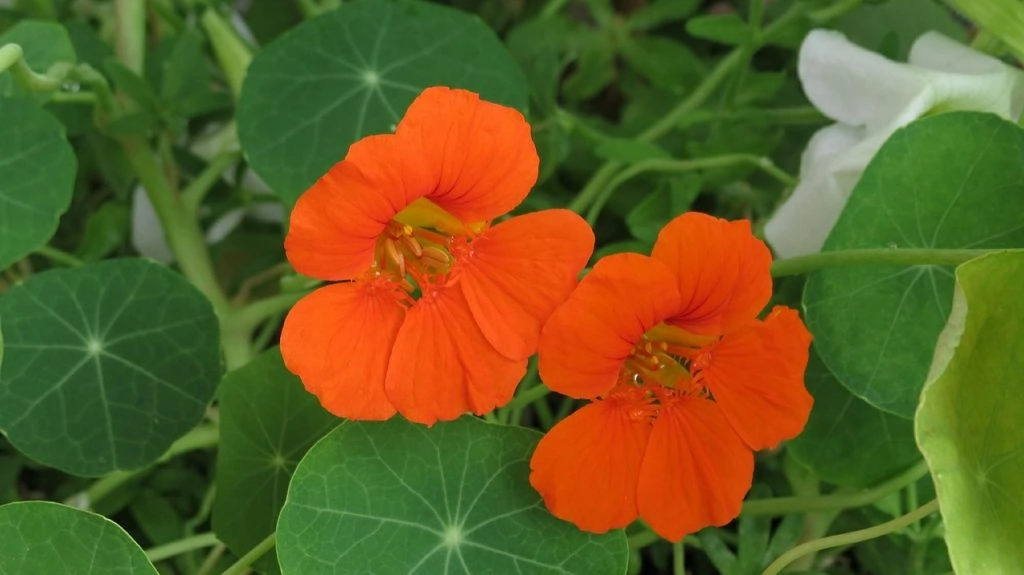
Nasturtiums are trailing edible flowers that are perfect for creating hanging baskets for hummingbirds due to their rich nectar and specially designed deep flowers.
Usually grown as annuals, they come in trailing or bush types. Plant the seeds just after the last frosts outdoors, and they need watering in the growing season and deadheading.
- Common Name: Nasturtiums
- Scientific Name: Tropaeolum
- Growing Zones: 2 – 11
- Sun: Full
- Soil: Well-drained
- Colors: Red, orange, yellow, pink.
- Height: 1 – 10 feet
- Spread: 1 – 3 feet
- Plant Type: Annual
4. Trumpet Honeysuckle
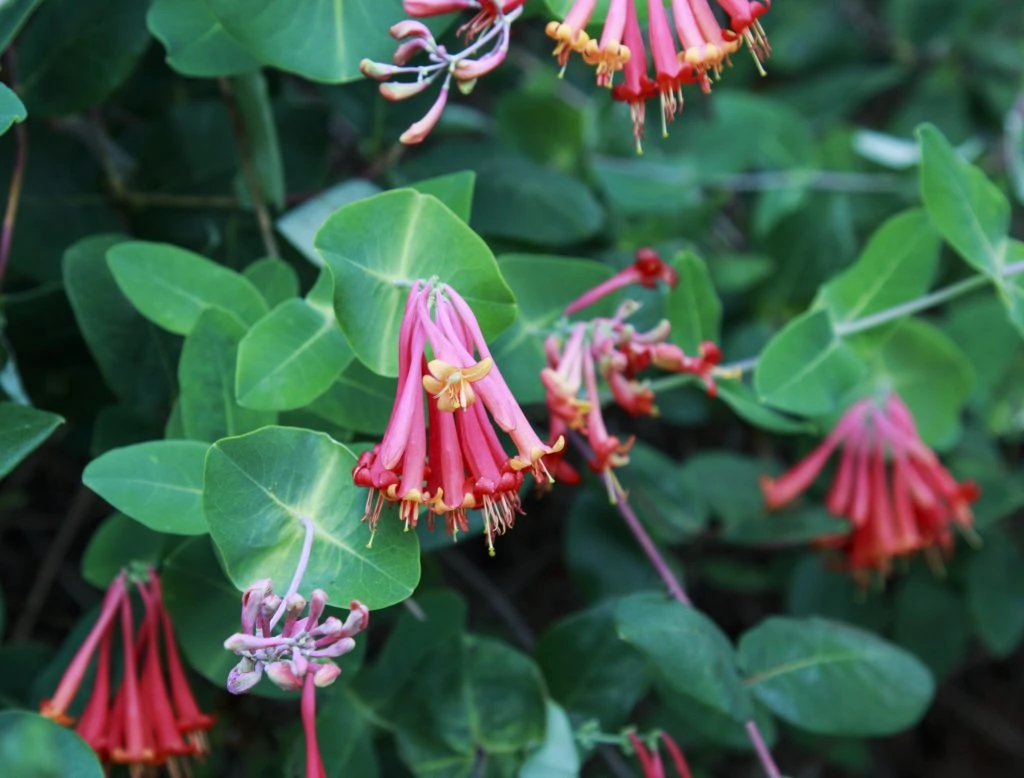
The Trumpet Honeysuckle, Latin name Lonicera sempervirens, is a fast-growing, twining vine from the Caprifoliaceae family, perfect for fences, arbors, or trellises. It may also be left to crawl on the ground, perfect for sprawling on concrete.
Be careful as some honeysuckle is invasive, especially the Japanese honeysuckle (Lonicera japonica), so stick to Trumpet Honeysuckle (Lonicera sempervirens) and check for your area what is invasive.
The Trumpet Honeysuckle is a favorite vine for attracting hummingbirds because of its bright orange-red flowers. When these flowers open, they reveal bright yellow stamens. They grow at the end of the stems in clusters of 10-20 flowers, and they flower from spring to fall. They look especially stunning amid the dark green, oblong leaves.
Aside from its long flowering season, the Trumpet Honeysuckle appreciates being in full sunlight to show off its beautiful flowers. It may still grow in partial shade, but the flowers won’t be as plentiful as when they’re given a full dose of sunlight.
- Common Name: Trumpet Honeysuckle
- Scientific Name: Lonicera sempervirens
- Growing Zones: 4 – 9
- Sun: Full sun, partial shade
- Soil: Medium moisture, organically-rich, well-drained soil
- Colors: orange-red
- Height: 8 – 15 feet
- Spread:3 – 6 feet
- Plant Type: Semi-evergreen, Deciduous, Evergreen Vine, perennial
5. Trumpet Vine
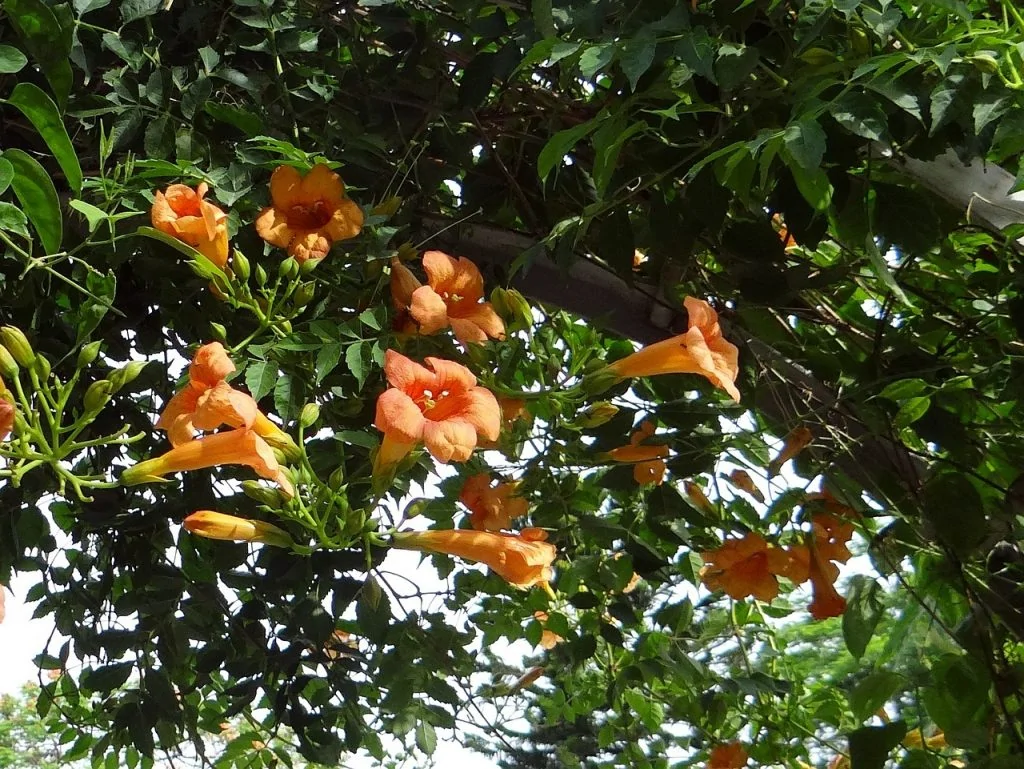
Trumpet vine, Latin name Campsis radicans, is from the family Bignoniaceae and a native of the eastern United States. It is a species of fast-growing and fast-spreading flowering vines, which can become invasive in western states if not controlled effectively through aggressive pruning. Look for hybrids if in western states.
Otherwise known as hummingbird vine, it lives up to its name because the flowers are too attractive for hummingbirds and make them come back repeatedly when they’re in bloom.
Some also call it the Trumpet Creeper because they can creep into crevices and shingles. Some find them valuable for covering rock piles and tree stumps. Their woody stems are strong enough to survive winter, but they’re also capable of destroying foundations, fences, and trees.
The Trumpet Vine is a plant that requires hardly anything to survive. It will thrive under full sunlight, with profuse flowers, when it gets at least 6 hours of direct light. It can also survive in partial shade but with fewer flowers. Regular watering is not necessary. Just keeping the soil moist is fine.
But regular pruning is necessary for the Trumpet Vine to keep it in check and prevent it from spreading too much. The best time is in late fall when you can cut it to nearly ground level. They will grow back sooner than you think, especially with full sunlight.
- Common Name: Trumpet Vine, Trumpet Creeper, Cow Itch
- Scientific Name: Campsis radicans
- Growing Zones: 4 – 9
- Sun: Full sun, partial shade
- Soil: Average, moist but well-drained
- Colors: orange, red, and yellow
- Height: 25 – 40 feet long
- Spread:5 – 10 feet wide
- Plant Type: perennial, Deciduous woody vine
6. Bougainvillea
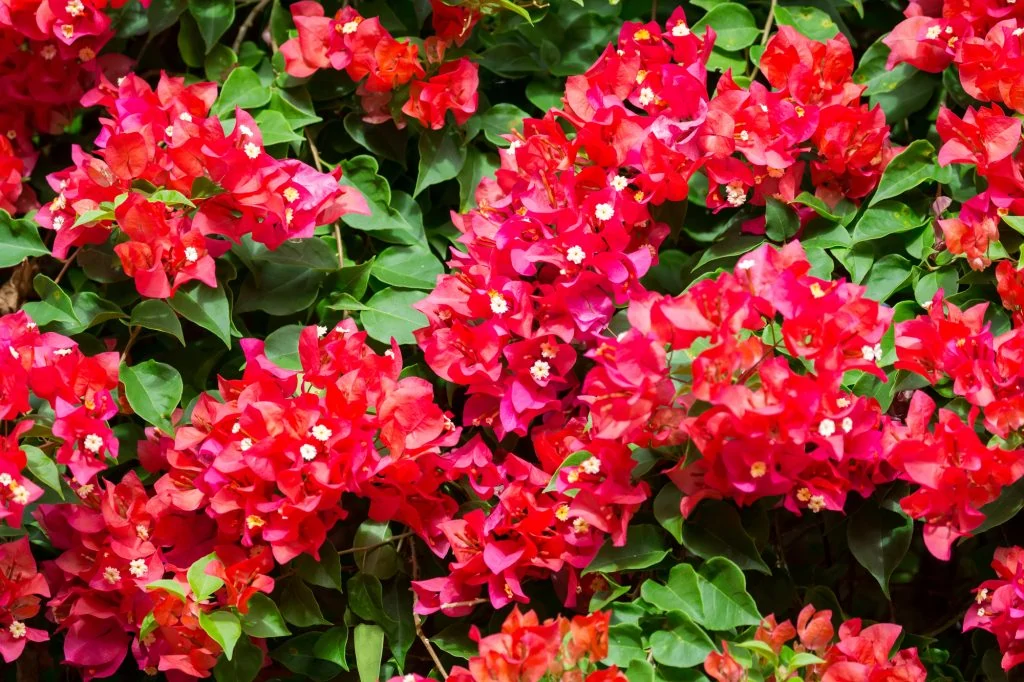
Bougainvillea is a genus of thorny, woody, ornamental vines that belong to the family Nyctaginaceae or the 4 o’clock family. They’re called the 4 o’clock family because they have a typical habit of their flowers opening at 4’oclock in the afternoon and closing them by morning.
Bougainvillea flowers are unique because what you see as “flowers” aren’t, in fact, the flowers themselves. The large, showy, colorful, paper-thin “flowers” are actually leaves or bracts. The flowers are the tiny, white ones in the middle of these leaves. The bracts act as protectors for the tiny flowers and help in attracting hummingbirds and other pollinators to the plant.
Hummingbirds truly appreciate bougainvillea flowers because they repeatedly bloom year-round, especially in zones 9-11. However, you need to bring them inside during winter because their roots may freeze if left outside. That’s why it’s better to grow them in containers when you live in regions with colder temperatures so you can quickly bring them inside.
Thorny bougainvillea flowers may be trained to cover fences and as security hedges. You may also let them crawl along the walls of houses, but caution must be taken when you have kids or pets that may accidentally graze themselves on the thorns.
- Common Name: Bougainvillea, paper flower
- Scientific Name: Bougainvillea glabra
- Growing Zones: 9 – 11
- Sun: Full sun
- Soil: loamy, well-draining soil
- Colors: yellow, orange, crimson, purple bracts, white flowers
- Height: up to 40 feet tall
- Spread: up to 40 feet wide
- Plant Type: Perennial, Deciduous, or Evergreen Vine
7. Hibiscus
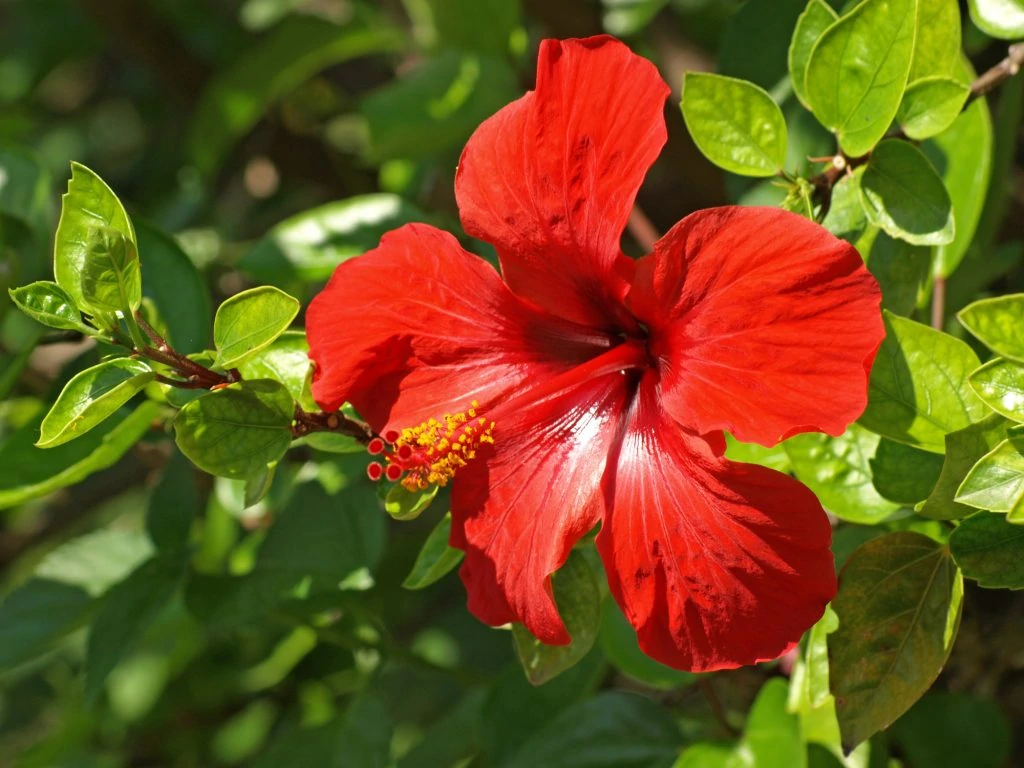
Hibiscus plants are from the mallow family, Malvaceae, and there are hundreds of varieties, including perennials and evergreens. Some perennials, like the Hibiscus coccineus, can grow in Zones 6 to 9, while some evergreens, like the Hibiscus rosa-sinensis, can grow year-round in Zones 9 and 10.
Hibiscus plants are characterized by large, trumpet-like flowers that may be colored red, yellow, pink, orange, and white. They may have five or more petals, and some single-bloom varieties flower for only one to three days. However, some tropical hibiscus species can repeatedly flower during their season.
Most Hibiscus plants start to flower from mid to late spring or mid to late summer, depending on the region. Some have also been known to flower until fall, but that may only be possible if the climate is mild.
If you want your hibiscus plants to flower, make sure they receive up to 6 hours of full sunlight daily. Watering your hibiscus depends on the weather. If it’s too hot, give it water daily. If it’s average, a couple of times a week will be enough, as long as the soil is moist. If it gets cold, hold off on watering until the soil is dry, and make sure to keep the plant indoors because they don’t really tolerate cold weather.
Hibiscus plants are a sight to behold when they’re in full bloom, and it’s understandable why they can attract hummingbirds. Taking care of your hibiscus will keep hummingbirds coming to your backyard for sure.
- Common Name: Hibiscus
- Scientific Name: Hibiscus
- Growing Zones: 6 – 10
- Sun: Full Sun
- Soil: Well-drained,
- Colors: Red, Yellow, Pink, Orange, and White
- Height: 3 – 8 feet
- Spread: 3 – 5 feet
- Plant Type: Perennial, Evergreen
8. Azalea
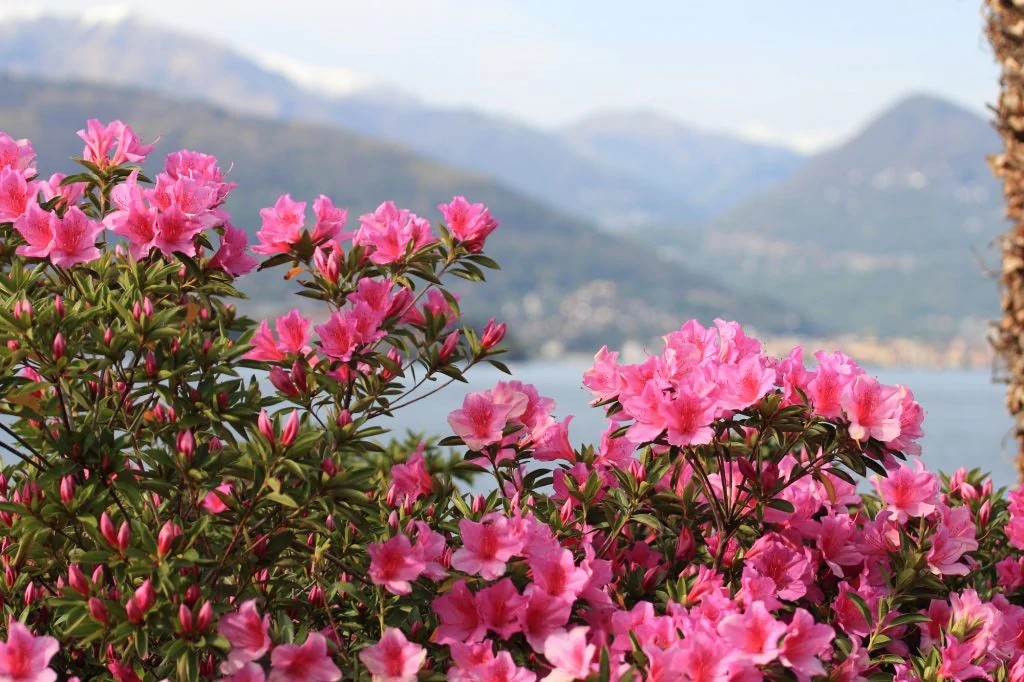
North America has 16 native species of azaleas, and they’re all deciduous Deciduous azaleas that drop all of their leaves in the fall and they grow back in the spring. They mainly flower in colors that range from white to pink and from yellow to orange.
Azaleas are flowering plants that belong to the Rhododendron family. One way to distinguish them from rhododendrons is to check the number of stamens. Azaleas generally have five stamens, while rhododendrons have 10. Also, while azaleas have smaller and thinner leaves, rhododendrons have large, impressive evergreen foliage.
Asian azaleas are mostly evergreen. They have colors that range from white to purple to red, but no yellow azaleas. Though they are called evergreen, they still do drop some of their leaves in the fall because they grow two sets of leaves. Spring leaves are the ones that drop in the fall, and they’re mostly thinner and larger. Summer leaves are thicker and smaller, but they do not fall in the winter.
Azaleas have many varieties but generally, most flower in the spring, around April and May, and some around June through September. Azaleas thrive in loose, moist, or well-drained, acidic soil (4.5 – 6.0 ph). If azaleas show signs of drooping because of too much sun or exposure to winds, revive them with slow watering.
Azalea flowers carry a floral scent that attracts hummingbirds. Their nectar is the treat that will make hummingbirds return to your backyard.
- Common Name: Azalea
- Scientific Name: Rhododendron
- Growing Zones: 7 – 9
- Sun: Filtered sunlight, partial shade
- Soil: Well-drained, acidic
- Colors: Pink, Lavender, yellow-orange, and white
- Height: as high as 10 feet
- Spread:3 – 5 feet
- Plant Type: Perennial, Evergreen, Deciduous shrubs
9. Agastache
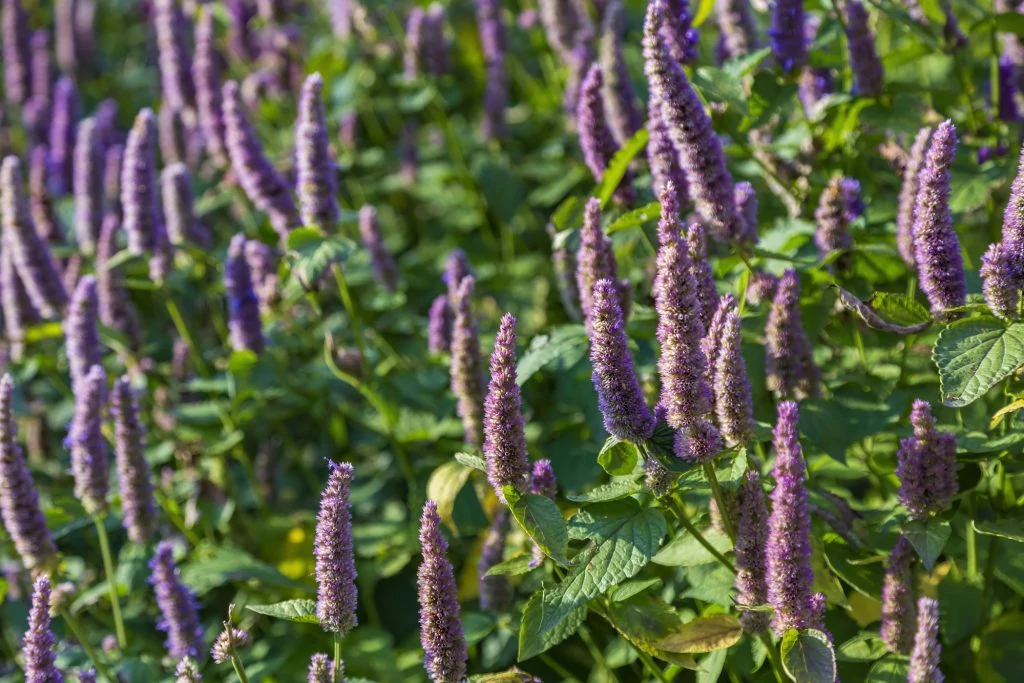
Agastache, pronounced as (“ah-GAH-stuh-kee”), are aromatic herbaceous perennials with as many as 22 species, most of which are native to North America. They are commonly referred to as “hummingbird mints” and “Giant hyssops”. Aside from being a hummingbird magnet, they can also be made into herbal tea.
Agastache flowers are attractive to hummingbirds because they literally stand out from among the leaves. They are about 3 to 4 inches long and appear fuzzy because they’re made of many tiny flowers growing in clusters. Their striking purple and red colors are a hummingbird’s favorite colors, and they will be unable to resist flocking to Agastache flowers, especially when they’re in full bloom in the summer.
The best way to grow Agastache flowers is to start them as indoor plants in May and then transplant them into flower beds in the summer. They require full sun and regular watering when they’re still trying to establish themselves. However, once they’re done, they are drought-tolerant and can easily be left to their own devices.
Agastache are desert plants, hence they can tolerate even the hottest days. That is also the reason why it’s not necessary to keep watering them once they’re established. Too much water will rot the roots, so make sure to just give them a good splash and then leave them alone to dry.
- Common Name: Agastache, Hummingbird Mint, and Hyssop
- Scientific Name: Agastache
- Growing Zones: 3 – 10
- Sun: Full Sun
- Soil: Lean soil, well-drained
- Colors: Blue, purple, red, orange, pink, and white
- Height: 3 to 5 feet tall
- Spread:
- Plant Type: Herbaceous perennial
10. Penstemon
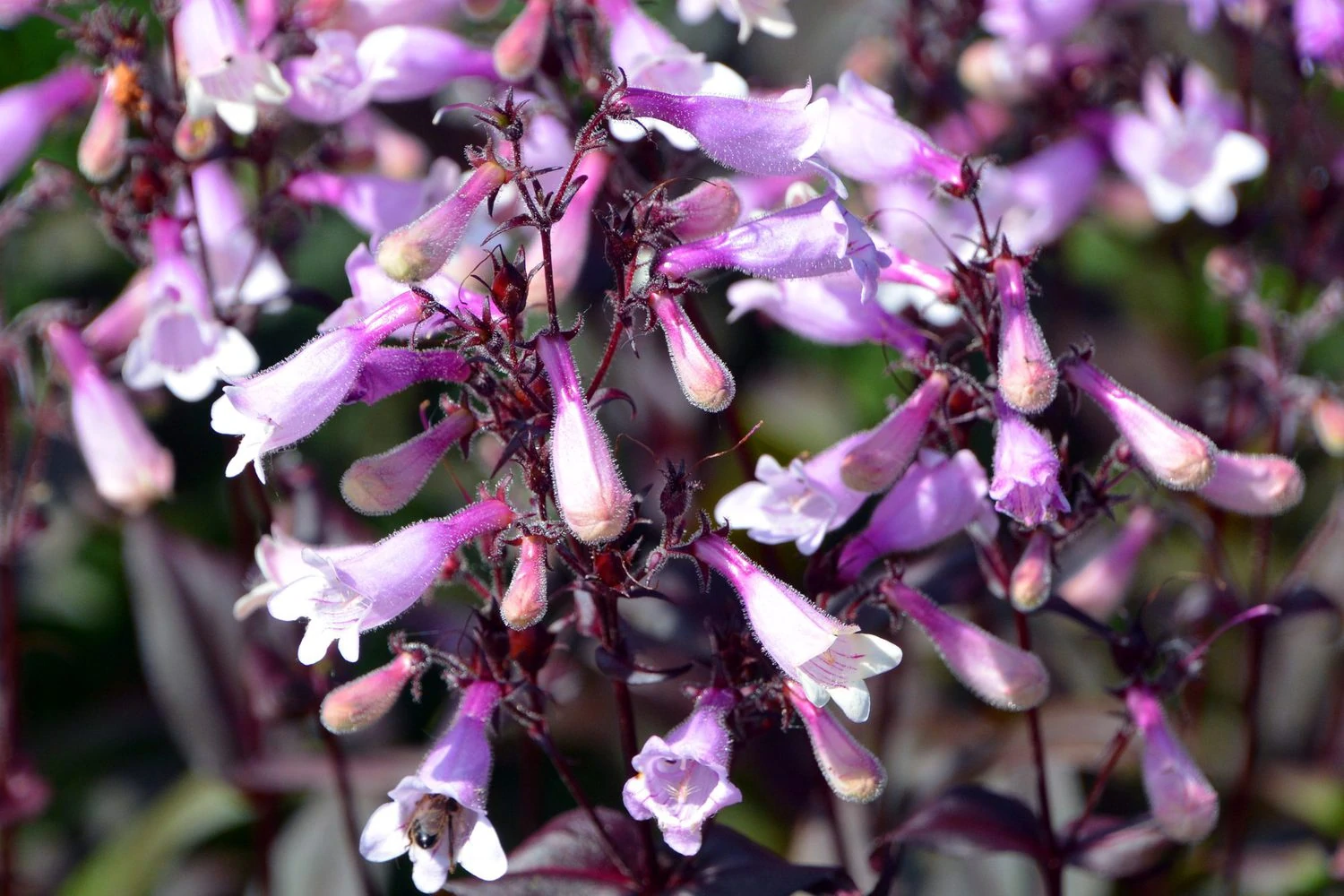
Penstemon is a genus belonging to the plantain family (Plantaginaceae), with over 250 different ornamental flowering plants, like snapdragons and foxgloves. It is also called Beardtongue because the pollen-free stamen that protrudes from the flowers has a tuft of small hairs.
With a wide number of species, there are many varieties of Penstemon to choose from to suit your backyard. They may have different sizes and different colors, but they all share these things- they’re all drought-tolerant, they attract hummingbirds and bees, they’re easy to take care of, and their lovely blooms brighten up any backyard.
Flowers of the Penstemon genus bloom in early summer. They become a focal point in a garden setting because of their spires and a colorful cluster of tubular flowers. There are many colors to display depending on the variety you’ve chosen. There are blue, purple, red, orange, white, pink, and yellow.
Hummingbirds always flock to Penstemon because they’re bright and colorful, and they’re nectar-rich.
The best place to plant penstemons is where they can get full sunlight. Flowers will bloom profusely, and stems will remain upright instead of drooping because of shade. They prefer nutrient-poor soil with moist conditions. They can tolerate drought, but it’s also good to give them a good watering every once in a while. It’s better to choose a variety suited to your soil condition and climate to make them last longer.
- Common Name: penstemon, foxglove beard-tongue, foxglove beardtongue, talus slope penstemon, and white beardtongue
- Scientific Name: penstemon
- Growing Zones: 3 – 9
- Sun: Full sun
- Soil: lean, fast-draining soil
- Colors: Blue, Purple, Red, Orange, White, Pink, Yellow
- Height: 6 to 12 inches, 1 to 3 feet, 3 to 8 feet
- Spread: 8 to 20 inches
- Plant Type: Perennial
11. Fuchsia
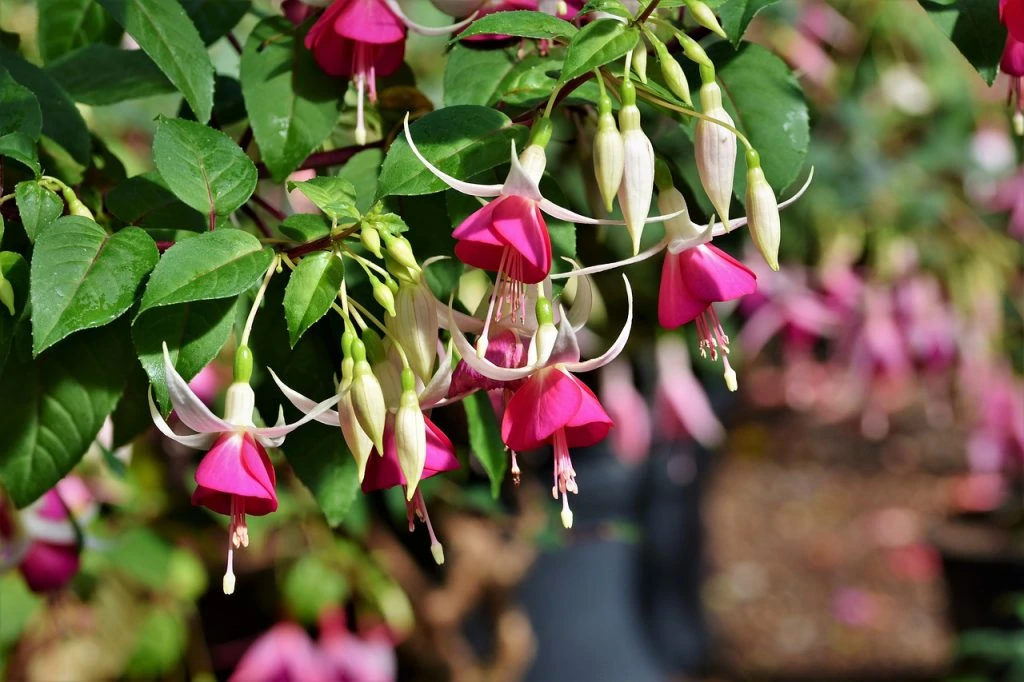
Fuschias are bright hardy perennials that provide nectar for hummingbirds all through the summer. They look especially great in pots and containers, with their beautiful flowers abundantly drooping over the sides.
Fuschias come in hardy varieties and are easy to grow in most soils. They require very little maintenance and so are a great addition to your garden.
They prefer dappled shade and not too much heat and will brighten up a more shady area of your patio.
Pinch off growing tips after flowering and fertilize every two weeks in the growing season. In colder areas, they may need to be brought inside in the winter.
- Common Name: Fuschia
- Scientific Name: Fuschias
- Growing Zones: 6 – 11
- Sun: Partial sun to shade
- Soil: well-drained moist soil
- Colors: Pink, purple, white, orange, and blue
- Height: 1 – 3 feet
- Spread: 1 – 5 feet
- Plant Type: Perennial
12. Columbine
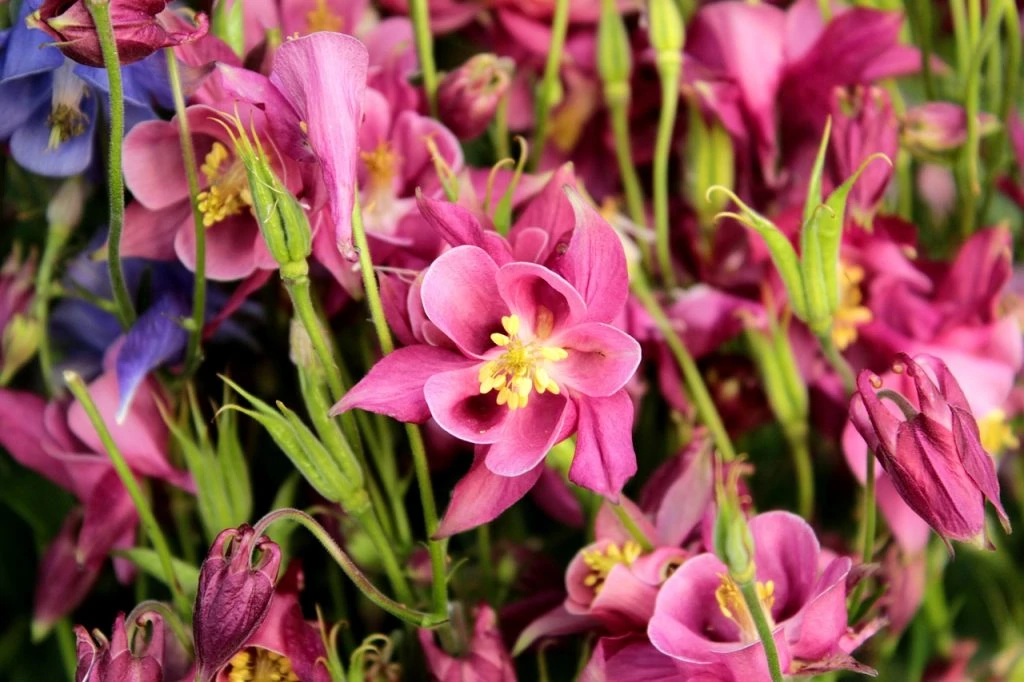
Columbines are one of the best plants to attract hummingbirds because their flowers come in a range of vibrant colors, and they grow well in partial shade.
Columbine is an elegant perennial plant with spiky, bell-shaped blooms that measure anywhere from 3 to 6 inches long. They are also known as Aquilegia.
There are many different varieties of columbine, but most grow in the sun to full shade and flower as early as spring, so they are a great option to start with if you’re trying to attract hummingbirds.
This hard-working flower is not only shade-tolerant, but they are also drought tolerant and deer resistant.
Sow the Columbine seeds directly in the ground in spring, and then they will self-seed if left at the end of the flowering season. If you want to get ahead, then sow the seeds indoors 6 to 8 weeks before the last frosts. Flowers will not appear on seed-grown plants until their second year.
- Common Name: Columbine, Aquilegia
- Scientific Name: Aquilegia
- Growing Zones: 3-9
- Sun: Full sun to partial shade
- Soil: Neutral PH, moist but not wet soil
- Colors: Red, Pink, Blue, Orange, White, and Yellow
- Height: 1 – 3 feet
- Spread: 1 foot
- Plant Type: Perennial
13. Eucalyptus
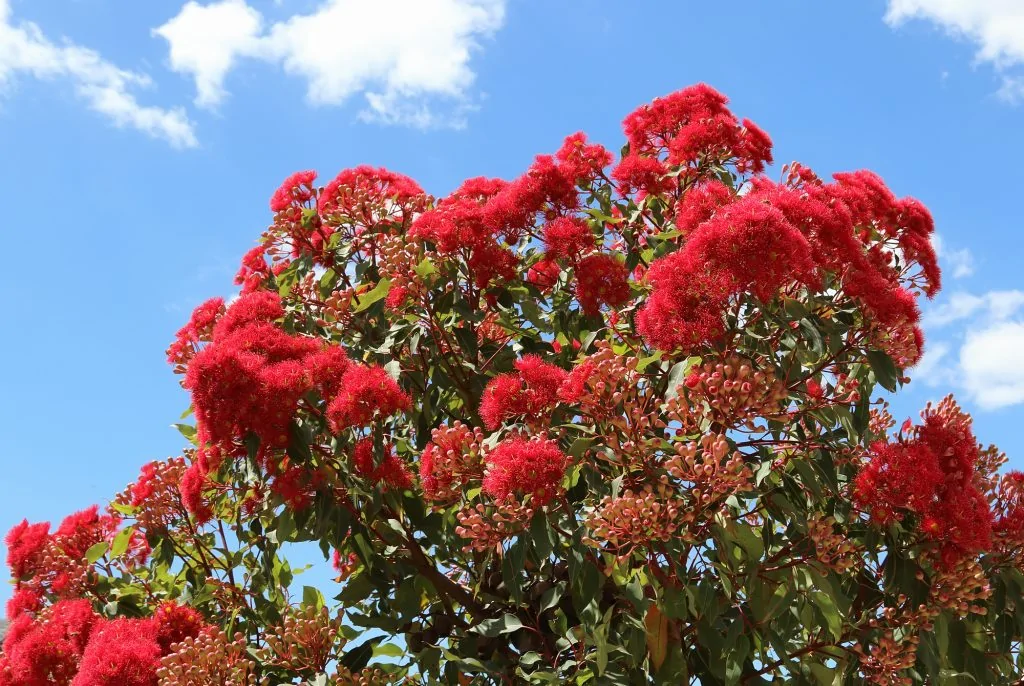
Eucalyptus are a large group of 700 species of flowering trees and shrubs. Almost all species are native to Australia, but some have found their way into Hawaii, California, Arizona, western Washington, western Oregon, and southwestern British Columbia.
Eucalyptus trees are also called gum trees or stringybark trees and are considered invasive species in places like California because they are highly flammable, so do not plant them in fire risk states.
Though most eucalyptus trees grow as tall as 800 feet in the wild, there are eucalyptus varieties that you can grow in your backyard like the Red-Flowering gum (Eucalytpus ficifolia) and the Silver dollar eucalyptus (Eucalyptus cinerea) that can reach from 20 to 50 feet tall. They provide good shade because of their height.
They’re also easy to maintain in urban areas because they can grow in any type of soil as long as it’s well-drained. However, they’re most suited for regions with tropical temperatures, like in zones 8-11. They don’t do well in the cold.
What’s fascinating about eucalyptus trees is that they technically have no flowers because they have no petals. The flowers that you would see are actually the numerous stamens that are freed from their petal-like enclosure. They are usually colored white, yellow, orange, pink, or red.
Hummingbirds, bees, and butterflies love the eucalyptus trees because they produce a large amount of nectar. Bees can use it to make eucalyptus honey. Hummingbirds also love the scarlet color of the blossoms, and they even make their nests in Eucalyptus trees.
- Common Name: Eucalyptus, Gum Tree
- Scientific Name: Eucalyptus
- Growing Zones: 7 -11
- Sun: Full Sun
- Soil: well-drained, slightly acid soil
- Colors: white, yellow, orange, pink, red
- Height: up to 120 feet tall (note: Pacific Northwest varieties) 820 feet (250 m) (Wild)
- Spread: 25 to 57 feet wide (note: Pacific Northwest varieties) 500 feet (150 m) (Wild)
- Plant Type: Perennial, Evergreen Tree
14. Tulip Tree
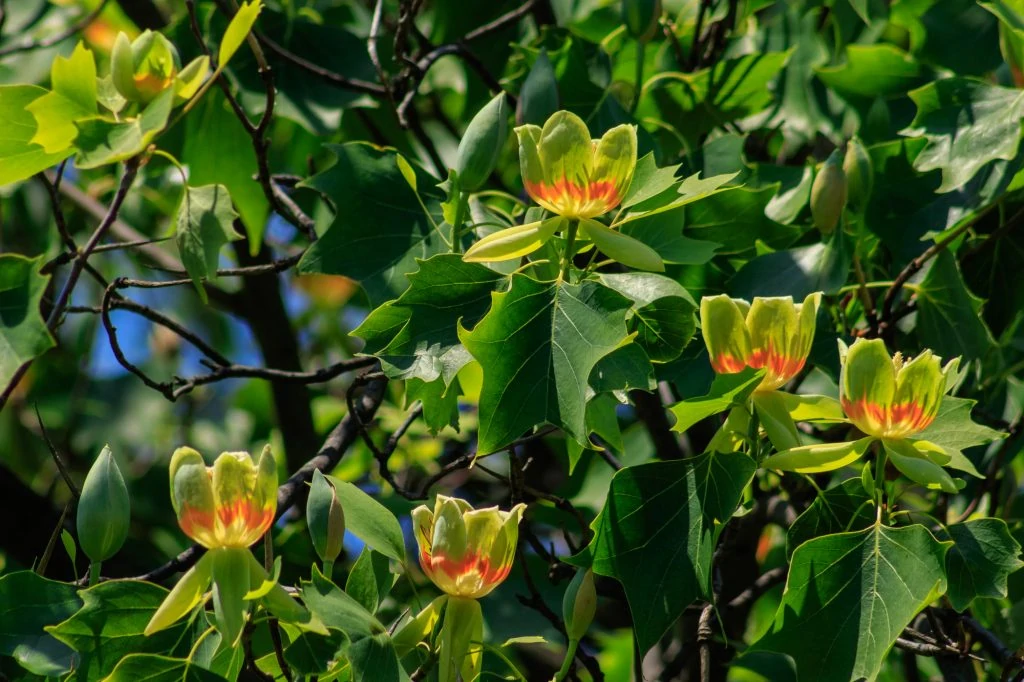
The Tulip tree (Liriodendron tulipifera) is the North American counterpart of the Chinese genus, Liriodendron chinense. The yellow-poplar, as it is commonly called, is fast-growing, strong, and known to be the tallest eastern hardwood tree.
Its bright yellow flowers, rich with nectar, are a feast for hummingbirds.
In the spring, the tulip tree showcases 2 inch long and 2-inch wide tulip-shaped flowers with six greenish-yellow petals and an orange band near the bottom part of the flower. This orange band, when seen from the top, appears to highlight the stamens in the middle, which probably makes it attractive to hummingbirds and other pollinators.
The leaves of the Tulip tree are also quite pretty. They’re star-shaped, smooth, and shiny, about 3 to 6 inches long. Though they’re bright green like most trees, they turn gold or vibrant yellow in the fall. Their stems have a certain fragrance, too.
Not many people often see these beauties because they’re usually high up, at around 50 feet or even higher. It may be daunting to plant a tree that grows as high as 90 feet, but it can be maintained to stay small by pruning. The Tulip tree prefers moist, well-drained soil and doesn’t do well with drought. But it does need a maximum of 6 hours of sunlight to grow fast.
- Common Name: Tulip Tree
- Scientific Name: Liriodendron tulipifera
- Growing Zones: 4 – 9
- Sun: Full sun
- Soil: moist, well-drained soil
- Colors: green-yellow, orange
- Height:70 to 90 feet
- Spread: 40 feet
- Plant Type: Perennial, Deciduous tree
15. Zinnia
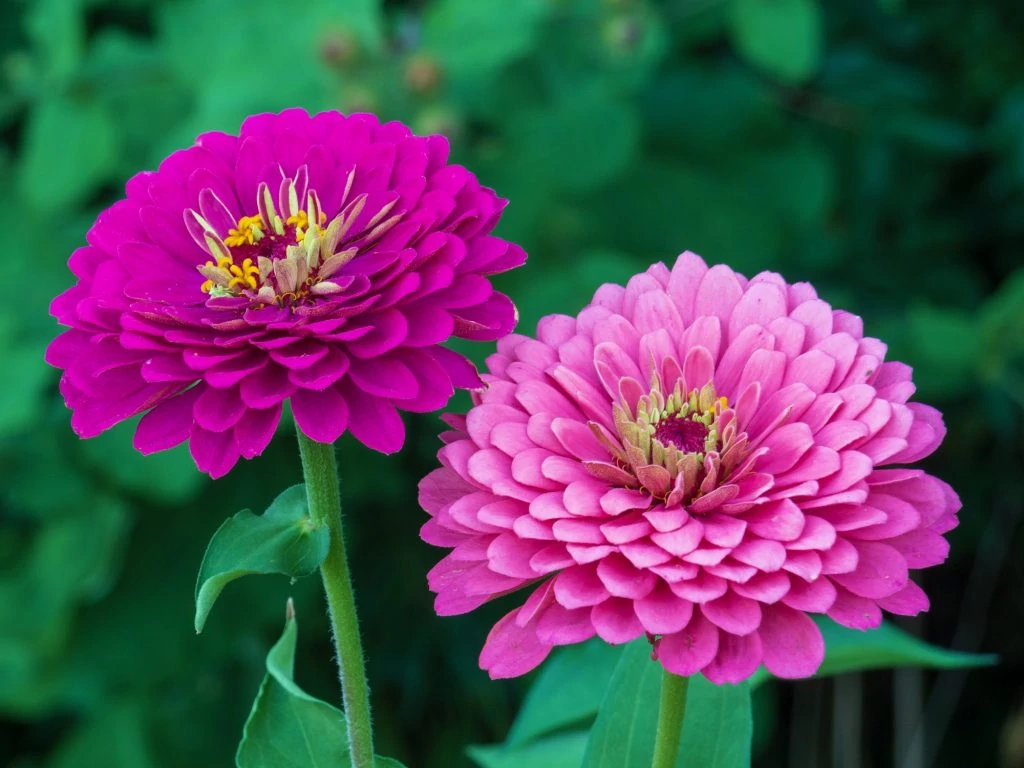
Zinnias are flowering shrubs native to the scrub and dry grasslands of North America. They belong to the genus Heliantheae or the sunflower tribe and to the much larger daisy family, Asteraceae.
There are three main types of zinnias based on the kind of petals that they have. Single-flowered zinnias have a single row of petals with a visible center. Double-flowered zinnias have numerous rows of petals with no visible center. Semi-double-flowered zinnias have numerous rows and visible centers.
The Zinnia elegans, with its tall stems and bright colors, is considered a classic and is most popular for backyards and gardens. It reaches 4 feet tall, has many brilliantly-colored flowers, has a long blooming period from early summer to frost, and attracts pollinators like butterflies and hummingbirds.
Growing zinnias is easy, but you have to plant them directly where you want them because they don’t like being transplanted. But once they become established under full sun and well-draining soil, you will be able to enjoy their bright blooms for a long time.
- Common Name: Zinnea, Zinnia
- Scientific Name: Zinnia elegans
- Growing Zones: Annuals in 2-8, Perennials in 9-11
- Sun: Full sun
- Soil: neutral to slightly alkaline, well-draining
- Colors: white, yellow, orange, pink, red, purple
- Height: 1 – 4 feet tall
- Spread:12 – 18 feet wide
- Plant Type: Annual, Perennial Shrubs
16. Crocosmia
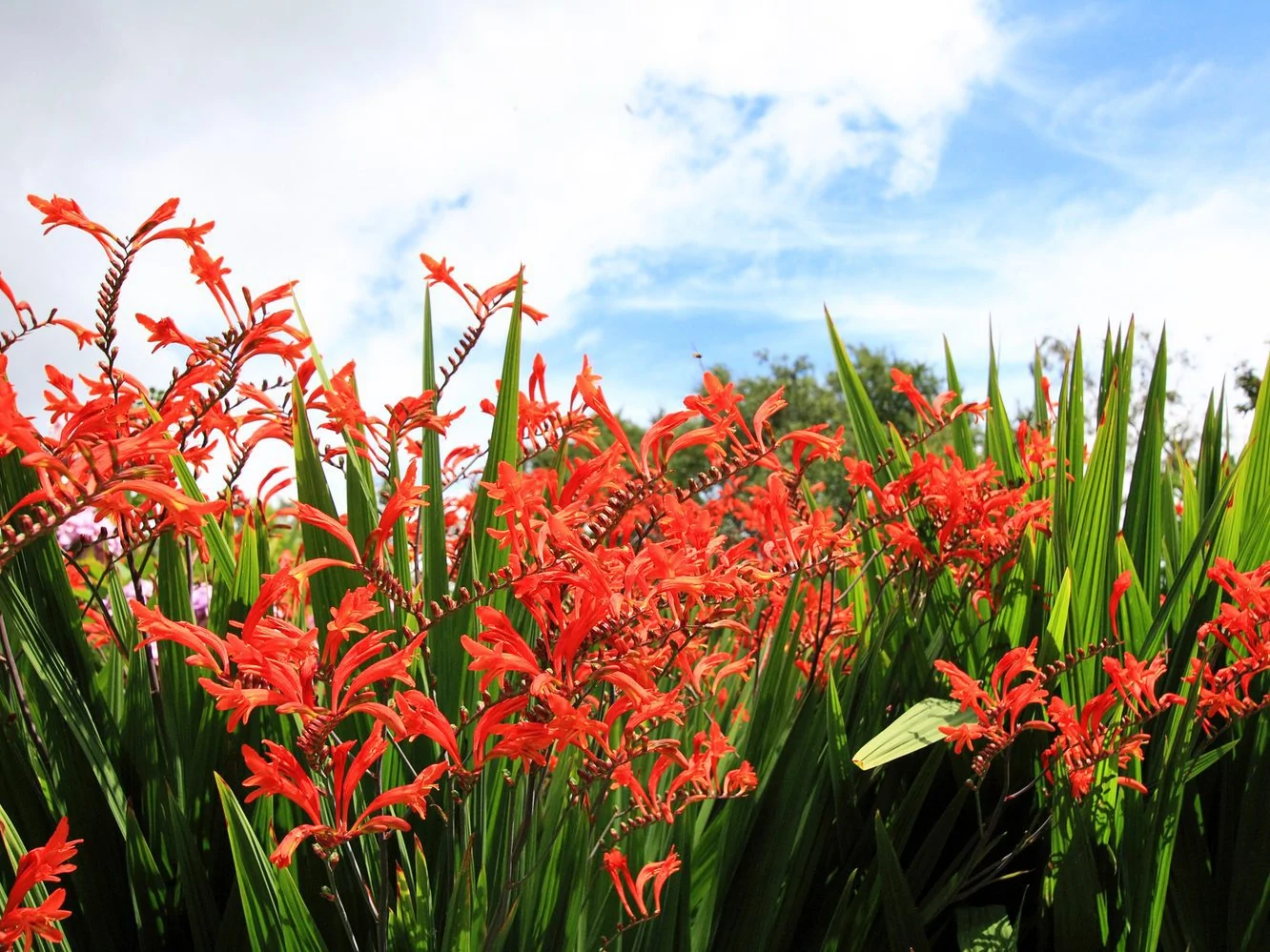
Crocosmia, commonly known as montbretia or coppertips, are flowering plants from the Iris family, Iridaceae. They are native to southern and Eastern Africa but have found their home all over the world.
The flowers of Crocosmia are trumpet-shaped and brightly colored red, orange, and yellow. When planted in moist, well-draining soil and exposed to full sun, these flowers bloom season after season in zones 5 to 9. These are ideal traits for attracting hummingbirds and other pollinators and having them return to your backyard.
When the flowers are not in bloom, the striking foliage of Crocosmia also provides visual interest. They are sword-shaped, bright green, and grass-like which add vertical movement to your backyard.
Crocosmia plants grow from corms or underground stems stocked with food supply to help plants survive winter. You plant them in the spring when frost is no longer a threat to the plants. They develop cormlets, so it’s easy to propagate them simply by breaking them off and re-planting them.
Some of the interesting varieties of Crocosmia include Crocosmia Lucifer (red flowers), Crocosmia Emily McKenzie (downward-facing orange blooms), Crocosmia Prince of Orange (20 orange flowers on each stem).
- Common Name: Montbretia, coppertips, falling stars
- Scientific Name: Crocosmia
- Growing Zones: 5-9
- Sun: Full sun, partial shade
- Soil: moist, well-draining
- Colors: red, orange, yellow
- Height: 1 ½ to 4 feet tall
- Spread: 12 to 18 inches
- Plant Type: Perennial
17. Daylily
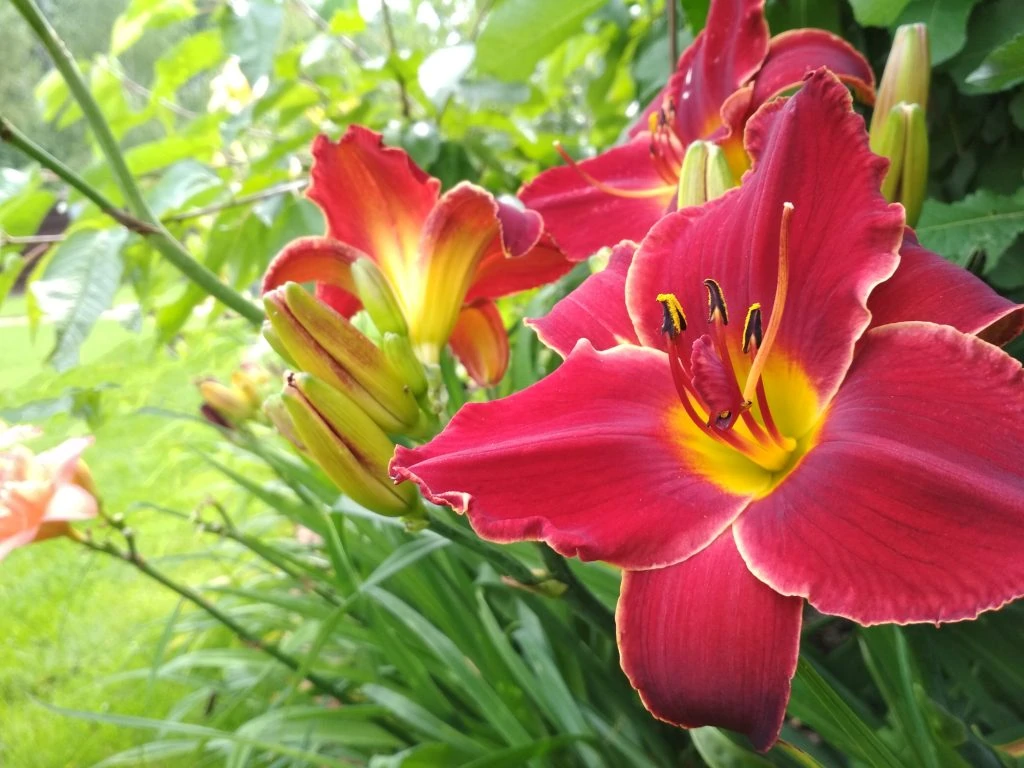
Daylilies are perennial plants from the family Asphodelaceae, popular among gardeners because of their attractive flowers. As many as 35,000 cultivars have been developed in order to create more variants with varying colors, plant hardiness, plant disease resistance, and plant sturdiness.
Daylilies are not true lilies, despite their name. They grow from fleshy roots, not from onion-like bulbs. Their flowers also form on “scapes” or leafless stems that can have as many as 12-15 buds on them. Each mature daylily plant can have 4 to 6 scapes, so you can have plenty of blooms for many seasons.
But, true to their name, daylily flowers only last a day. The good news is that a new flower grows after so that each plant, with its many scapes, can have a lot of blooming flowers from mid-spring to fall.
In order to keep the Daylily plant blooming its brilliantly-colored flowers, they have to be placed in an area that will receive at least six hours of sunlight. While they are drought-tolerant, it’s important to keep them hydrated with water, especially when the scapes and buds are still forming.
Hummingbirds are easily attracted to daylilies because of their bright colors, particularly the reds and purples. They are drawn to the tubular varieties, too because those are the flowers that hold the most nectar.
- Common Name: Daylily
- Scientific Name: genus Hemerocallis
- Growing Zones: 4 – 9
- Sun: Full sun
- Soil: Slightly acidic to neutral
- Colors: white, yellow, orange, pink, red, purple
- Height: 3 to 4 feet tall
- Spread: 2 to 4 feet wide
- Plant Type: Perennial
18. Calibrachoa
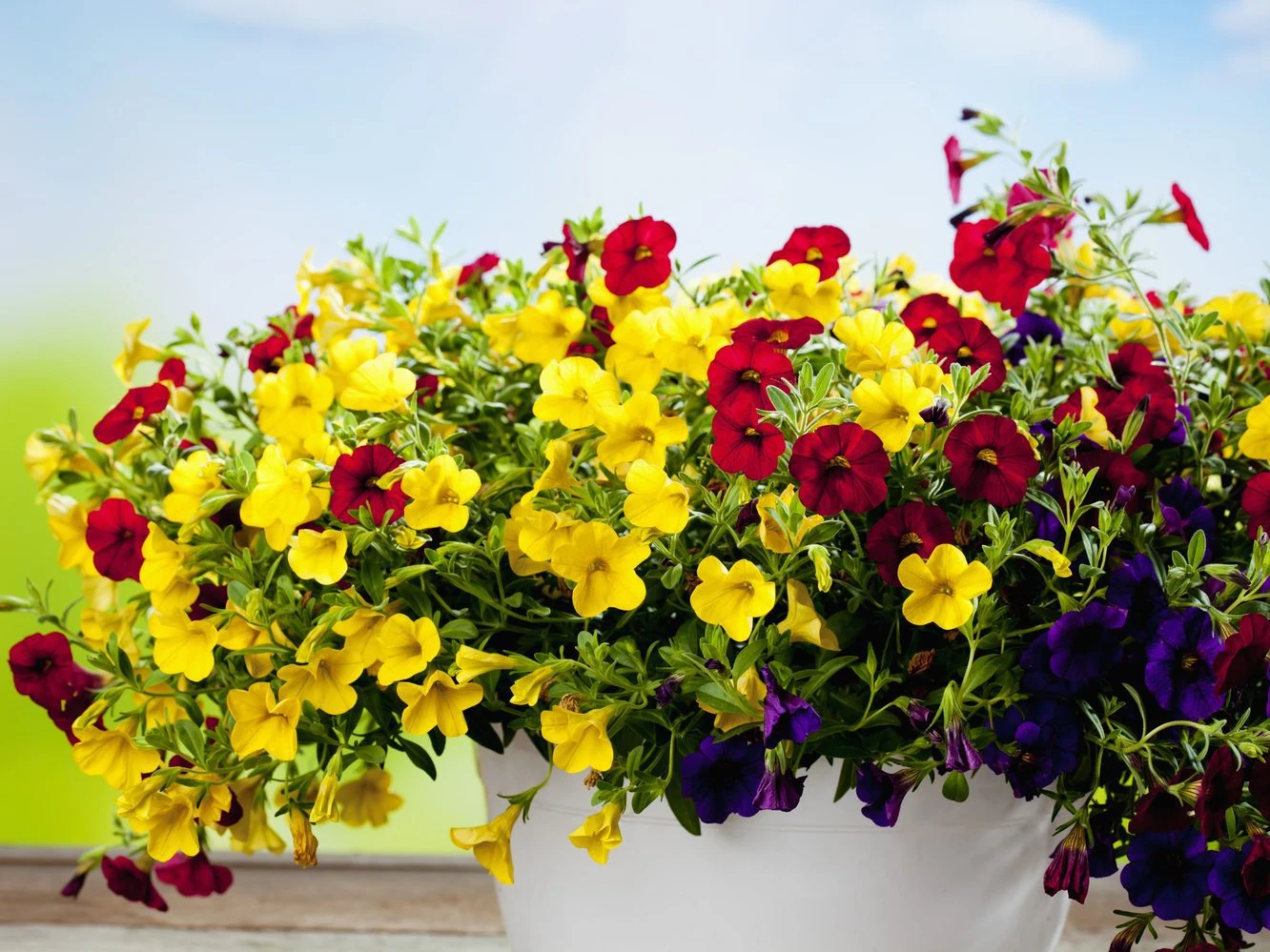
Calibrachoa, more commonly known as million bells or trailing petunia, are small shrubs belonging to the Solanaceae family. They are a relatively new species of ornamental plants, having been introduced only in the 1990s. But they’ve grown popular because of their prolific, colorful blooms that look like small petunias, which is why they’re also called mini petunias.
Calibrachoa plants are well-suited for containers and hanging baskets since they grow so fast and have a tendency to cascade. They can only grow to as high as 12 inches, but they do give you so many flowers you’ll hardly see any foliage.
The flowers of the Calibrachoa plant are small, bell-shaped, and pretty colorful. They come in shades of coral, yellow, orange, red, pink, blue, purple, burgundy, lavender, and cream. There are even varieties that give you dual-colors and veined and segmented petals. Regardless of the diversity of the flowers, calibrachoa flowers attract pollinators like hummingbirds.
They are not hard to grow and maintain. Calibrachoa grows well in full sun and well-draining soil. Just pay attention to the weather because if it gets too hot, you may need to adjust the amount of water that you give them.
- Common Name: Calibrachoa, million bells, trailing petunia, mini petunia
- Scientific Name: Calibrachoa
- Growing Zones: 9 – 11
- Sun: Full Sun to Part Shade
- Soil: Moist, rich, well-drained
- Colors: coral, yellow, orange, red, pink, blue, purple, burgundy, lavender, cream
- Height: 6 – 12 inches tall
- Spread: 12 – 24 inches wide
- Plant Type: Perennial
19. Coneflower
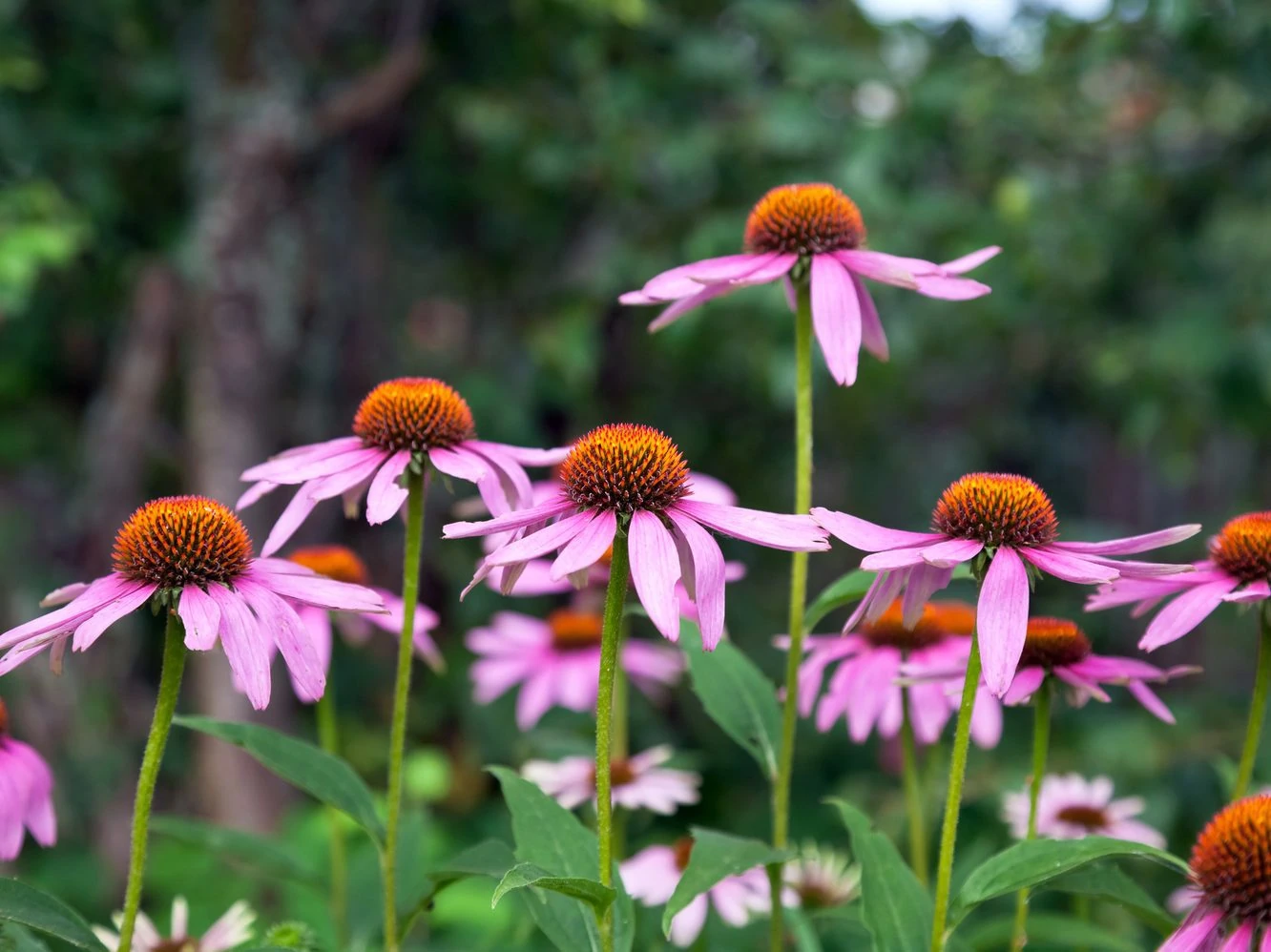
Coneflower is the common name for Echinacea, a genus of flowering plants that belong to the daisy family, Asteraceae. Their scientific name, Echinacea, stands for “sea urchin” in Greek because of their shiny central disk.
There are ten species of coneflowers, named so because their petals tend to point downwards once the central flower head opens, thus forming the shape of a cone. The most common backyard ornamental coneflower is Echinacea purpurea, or the purple coneflower, which is a native of eastern North America.
Coneflowers are large, about 6 inches across, and their stalks reach about 5 feet high. There are other colors available, like pink, red, orange, yellow, and white, depending on the variety. They love being in full sun, like 6 hours daily, and prefer to have well-drained soil. When these conditions are met, you’ll enjoy the flowers from summer to fall.
The brightly colored flowers, particularly the reds and purples, attract hummingbirds and other pollinators like bees and butterflies repeatedly. Their central cone is nectar-rich, and that draws them for a feast.
- Common Name: coneflower
- Scientific Name: Echinacea
- Growing Zones: 3 – 9
- Sun: Full Sun
- Soil: varies
- Colors: white, yellow, orange, pink, red, purple, green
- Height: 2 to 5 feet tall
- Spread: 1 ½ – 2 feet wide
- Plant Type: Perennial
20. Butterfly Weed
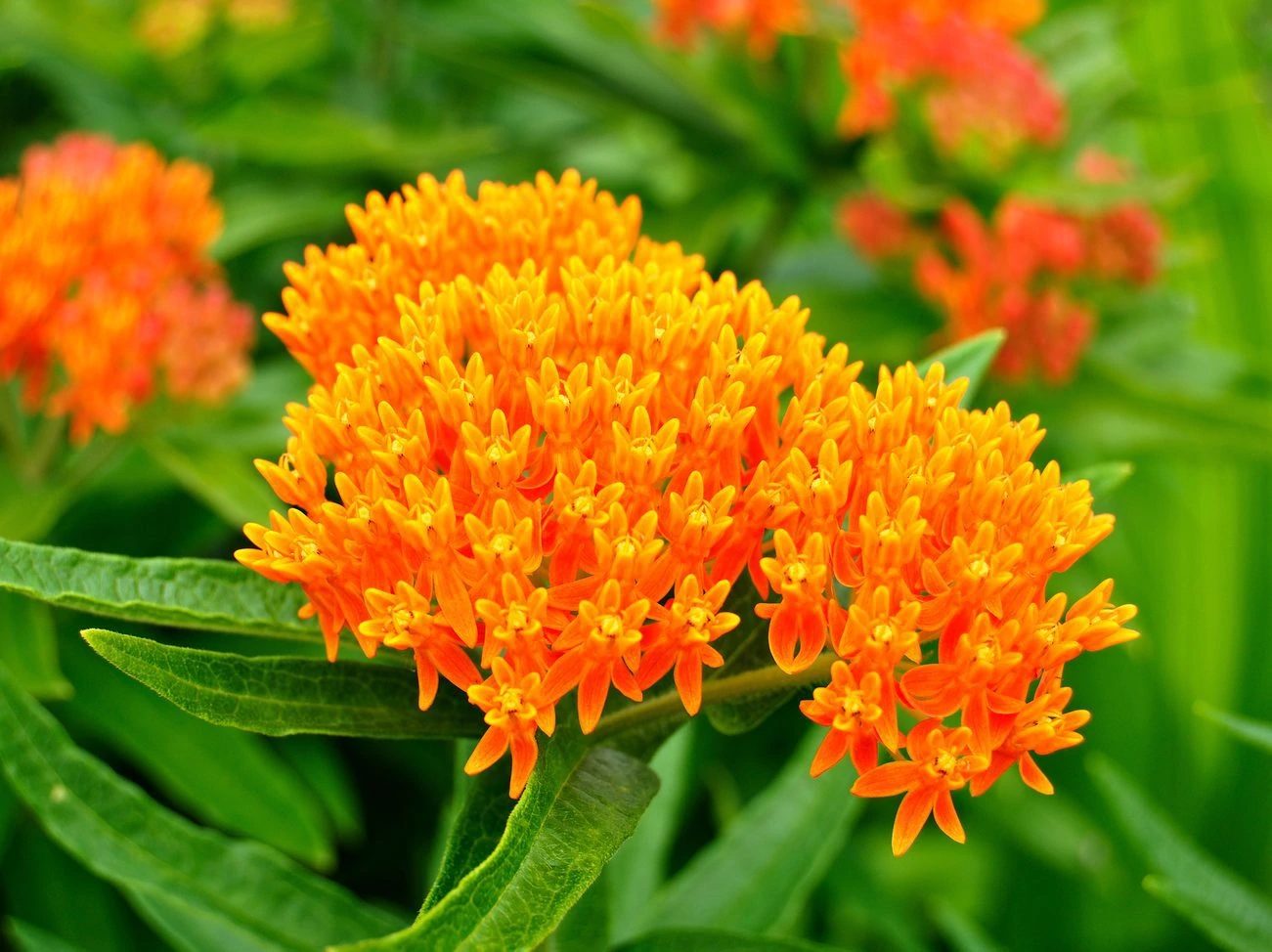
Butterfly weed, Asclepias tuberosa, is a bushy, showy plant that is also known as Pleurisy Root because its tough root was chewed by Indians as medicine for pleurisy and other pulmonary diseases. It is also called Orange Milkweed, as its flowers are orange and it belongs to the Milkweed family, but it doesn’t have a milky sap.
If you want to attract butterflies, bees, and hummingbirds to your garden, you need to plant Butterfly Weed. The orange to yellow, nectar-rich flowers grow in clusters atop thick, hairy stems amid a bright green, lush foliage.
Enjoy the blooms from late spring to summer but be careful to remove their seed pods if you don’t want them to self-seed, as they can be invasive.
Butterfly weed plants are easy to grow, but they take a long time, as long as three years, before you can see them flower. It’s also best to plant them in a permanent place because their roots are tuberous, and they don’t like to be moved. But they thrive in full sunlight and will rarely require regular watering once they’re established.
Planting Butterfly Weed does not only beautify your garden and provides nectar to hummingbirds, bees, and butterflies. It also prevents the extinction of monarch butterflies that rely on the milkweed leaves as food for monarch caterpillars.
- Common Name: Butterfly Flower, Butterfly Weed, Orange Milkweed, Pleurisy Root
- Scientific Name: Asclepias tuberosa
- Growing Zones: 3 – 9
- Sun: Full sun
- Soil: poor, dry, well-drained soil
- Colors: orange, yellow or red
- Height: 1 to 2 feet tall
- Spread: 12 to 18 inches wide
- Plant Type: Perennial

